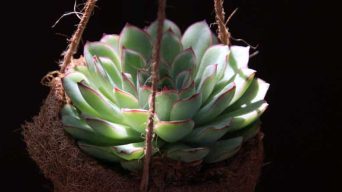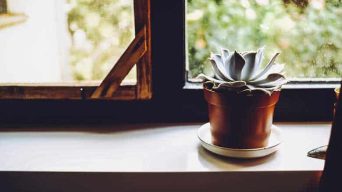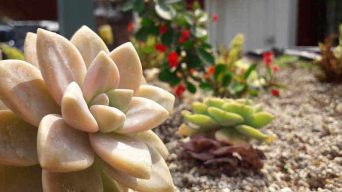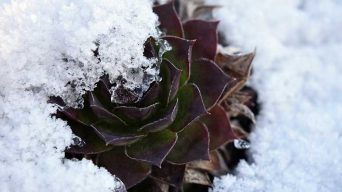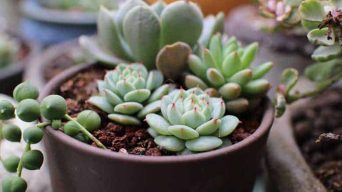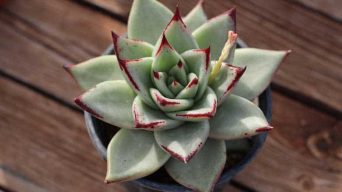Growing succulents can be a fun and rewarding home or garden decoration activity.
They are beautiful plants, and their low maintenance needs make them an ideal choice for novice gardeners.
With the right knowledge on how to care for succulents, you can ensure your plants stay healthy and look amazing.
Overview
Succulents are plants that have evolved to thrive in arid environments, making them an ideal choice for gardeners who live in areas with frequent droughts or those looking for a low-maintenance garden.
These plants store water in their leaves or stems, as they must be able to survive without too much hydration.
Succulents come in a wide variety of colors, shapes, and sizes, so there is sure to be one that appeals to any taste.
They can be grown indoors and outdoors in pots or planted directly into the ground – perfect for adding life and vibrancy to any garden setting.
Beyond being aesthetically pleasing, succulents are incredibly tough and resourceful plants requiring little maintenance.
Once established, they will typically only need watering once every few weeks and do not need regular pruning or fertilizing. This makes them a great option for busy gardeners who don’t have the time or inclination to spend hours caring for their plants.
Furthermore, succulents may even help increase the humidity in your home if placed indoors, thanks to their ability to transpire more water than other plants due to their drought-resistant nature.
How To Care For Succulents
Want to make sure your succulents stay healthy and vibrant? Caring for them properly is essential.
Here’s a rundown of the basics you need to know about succulent care.
Watering
One of the most important things to remember about succulent care is that succulents do not need a lot of water. Succulents will rot if they are overwatered.
The best way to water succulents is to wait until the soil is dry before watering again.
When caring for succulents, it’s important to remember that they don’t need a lot of water. Too much can cause them to rot!
The best way to water is when the soil feels dry if you stick your finger in it; if it feels moist, wait until it dries before watering again.
Avoid pouring water from above – this will get into the roots and not be able to evaporate. Instead, pour it onto the soil at the base of the plant.
Succulents may also benefit from deep watering occasionally – water till it starts coming out of the drainage holes. In winter, reduce the watering frequency or even stop altogether; resume in spring.
Light
Succulents need plenty of bright indirect light to thrive and remain healthy.
While they can be exposed to full sun, protecting them from direct sunlight during the hottest part of the day is important, as this can cause sunburn and leaf loss.
For those who are growing succulents indoors, place them near a window that receives plenty of bright and indirect light, preferably one facing east or west.
For those cultivating them outdoors, ensure they get enough sunshine by locating them in a sunny spot.
If your succulents are not getting enough light, they may attempt to stretch towards illumination sources, and you may need to move them somewhere sunnier gradually.
During this process, it is essential to do so carefully to avoid unpleasant burns.
Even if your succulent is already receiving the necessary amount of light for optimal health, you should still take precautions, such as occasionally rotating its pot for the plant to receive equal lighting on all sides.
Additionally, giving your succulent an occasional break from direct sunlight can help keep it from becoming overwhelmed by too much heat and enable it to rest from all its growth activities.
Soil
Succulents require soil conditions that promote air circulation and allow for rapid drainage so their roots can obtain the oxygen they need.
The best option for this is a cactus or succulent potting soil mix, which will provide the perfect environment for healthy growth.
You can also create your potting mix with equal parts potting soil, coarse sand, and perlite. This combination makes a light and airy soil ideal for succulents to thrive in.
Planting with too dense soil can lead to numerous problems, such as a lack of proper drainage and insufficient oxygen for the plant’s root system.
Garden soil is also not recommended since it is too dense to enable sufficient airflow through the root structure of succulents. It’s important to watch for signs of overwatering succulent plants caused by lack of drainage from dense soils, as this can lead to root rot and other issues that can damage the succulent.
Temperature and Humidity
Succulents thrive best in a cool, dry climate. The ideal temperature for their growth is between 68° – 80° Fahrenheit (20 – 27°C) during the day and 50° – 70° Fahrenheit (10 – 21°C) at night.
Choosing a spot with good air circulation when growing succulents indoors is important, as they can quickly rot if surrounded by too much humidity. To reduce humidity levels in your home, you can use a dehumidifier or find a location with better air circulation.
Outdoors, succulents prefer spots protected from the wind and where the temperature will not drop below 50° Fahrenheit (10°C).
You can move your succulents outdoors in the summertime but must bring them indoors before temperatures dip below 50° Fahrenheit (10°C) to ensure their survival.
Fertilizer
Succulents do not require frequent fertilization, and it’s crucial to be aware that excessive fertilizer can be detrimental.
To ensure you provide the right nourishment, use a balanced liquid fertilizer during the growing months, but dilute it to half-strength.
It is best to abstain from fertilization during winter as it can be damaging.
When you fertilize succulents, remember to pour the fertilizer around the base of the plant instead of directly on top of the soil. This will enable roots to absorb nutrients more efficiently.
Additionally, ensure your fertilizer does not contain excessive nitrogen, as this could adversely affect your succulent plants.
Excessive nitrogen in a fertilizer can burn and damage succulents, so always read the label carefully before applying any product to your plants.
Potting
When potting succulents, it is important to ensure they have proper drainage. Using containers with holes in the bottom can help prevent the roots from becoming overly saturated, which can cause them to rot.
To ensure your succulents thrive, ensure that each container you choose has sufficient holes for water to escape.
Terracotta or ceramic pots are ideal for regulating soil temperature and absorbing water, while plastic pots should be avoided as they do not allow for proper aeration of the soil.
When first starting out, it is best to choose a pot that is only 2 inches (5 cm) wider than the succulent is tall. However, as the succulent grows, you can gradually upgrade it to a larger size.
Furthermore, make sure you have a deep enough pot so that the roots of your succulent have enough room to spread out.
Repotting
Repotting succulents every 2-3 years or whenever their roots become crowded in the pot is essential to maintaining healthy and vibrant plants.
Taking a few extra steps when repotting can help ensure a successful transition for your succulent and help them stay happy and healthy for a long time.
When repotting succulent plants, fresh soil is essential because the old soil will have lost its nutrients.
It’s best to use a pot slightly larger than their current one — if you use a pot that is too large, their roots won’t absorb enough water, and the succulent plant will start wilting.
To begin, carefully remove the succulent from its existing pot and loosen the soil around its roots. Gently spread out all of their roots before placing them into the new container, and make sure to fill any gaps between the succulent and pot with fresh soil before tamping down.
If they are root-bound (roots have grown out of the pot and are wrapped around on the inside), gently break up the roots with either your fingers or something blunt like a pencil before repotting them.
After repotting, hold off on watering your succulent for at least one week — after this period, remember only to water them thoroughly when the soil has dried out completely.
Transplanting
Selecting the appropriate spot is crucial when relocating succulent plants.
Look for a sunny spot in your garden with well-drained soil. This will give your plants the best chance of thriving.
To transplant succulents, dig a hole twice as wide as the pot they are currently in. Carefully loosen the soil around each plant before placing them in their new home in the ground.
Use fresh soil to fill any gaps, then lightly tamp down the ground around them. After this, water them thoroughly and wait a few weeks for the roots to re-establish themselves in their new environment.
Transplant shock can be a risk when moving succulents from one location to another, so you should monitor their progress regularly during those first few weeks after transplantation.
Ensure they are receiving enough sunlight and don’t stay wet for too long, as both of these factors can cause stress on your plants while they adjust to their new home.
Additionally, you should avoid fertilizing newly transplanted succulents until they have settled in – usually after two or three months – as too much fertilizer can impede root growth or burn delicate foliage.
Cover young plants with plastic sheeting or other materials to protect them from frost damage during wintertime if the temperature drops below freezing.
Lastly, ensure your soil is loose and well-aerated so that oxygen can easily reach your plants’ roots and promote healthy growth.
Pruning
You don’t need to prune most succulents. However, those with longer stems need occasional trimming to avoid becoming “leggy” from the lack of sunlight.
It is important to use sharp scissors and make clean cuts to achieve the best results when pruning.
Also, disinfecting your scissors after each cut can help prevent diseases from spreading between plants.
Dead leaves or flowers should also be removed regularly, which can attract pests and other diseases. Doing so will help ensure the health of your succulents and keep them looking their best for longer.
When trimming, aim for a balanced shape and leave enough stem length to create even coverage of light throughout the plant’s structure. This will help your succulent to thrive since it will receive consistent amounts of light rather than too much or too little in certain areas.
Make sure not to remove too much foliage at once – taking only a few leaves at a time is better as it gives the succulent more time to adjust and regrow without becoming overstressed.
Lastly, if you plan on propagating cuttings, always use fresh scissors that have been properly disinfected beforehand, as this greatly reduces the risk of potential diseases infecting both new and existing plants.
Pests and Diseases
It is important to remember that succulents are not very hardy plants and can easily succumb to damage from pests or diseases.
Therefore, preventive measures should always be taken to keep them healthy.
To ensure that your succulents stay healthy and free of pests and diseases, there are several steps you should take.
- Avoid overwatering, which can cause root rot if the soil remains constantly moist.
- To receive optimal sunlight, keep the succulents in a sunny location.
- When transplanting into new soil, discard the old soil as it could contain pests and diseases that may infect your succulents.
- Remove any excess leaves or flowers to prevent attracting any pests or diseases.
- Provide adequate air circulation around them, as too much humidity is an ideal breeding ground for pests and diseases.
- If a disease does occur, use a fungicide to help control it.
- Inspect your succulents regularly for signs of pests and diseases and treat them accordingly if found.
These precautions will help maintain the health of your succulents and prevent unwelcome guests from invading your precious plants.
Additionally, try diversifying the types of succulents you own for added resilience and variety.
You can also monitor humidity levels with a digital hygrometer to ensure it does not become too high in their environment. This will reduce their susceptibility to disease even further.
Fertilizing periodically is also beneficial as long as you avoid overfeeding, which can lead to nutrient toxicity and other problems with growth.
By taking these extra measures and the primary ones mentioned above, you’ll have a beautiful succulent collection safe from harm!
7 Essential Succulent Care Tips for Beginners
Are you just getting started with succulents and want to learn how to make them thrive? If so, then these tips are for you!
Here are some ideas to help you get started:
- As a beginner, select easy-to-care-for succulents from the many varieties available.
- Begin with a small succulent pot, ideally 4 inches or less in diameter.
- Use well-draining soil, such as a succulent potting mix or cactus mix, to ensure the health of your succulents.
- Water your succulents sparingly, once a week or less during the winter.
- Be mindful not to overwater your succulents, as they can easily drown.
- Place your succulent pot in a sunny spot, ensuring it receives at least 6 hours of indirect sunlight daily.
- Repot your succulents every 3-4 years to give them more space as they grow.
Looking after succulents doesn’t have to be complicated. You can keep your succulents healthy and thriving with just a few simple steps.
Follow these tips, and you can care for your succulents successfully!
Final Thoughts
Succulents make a wonderful addition to any garden and can last for years with the proper care and attention.
As a beginner, understanding the basics of succulent care is essential to successfully creating a vibrant and healthy garden.
This article provides some useful tips to help you establish your succulent garden and ensure it lasts for years to come.


